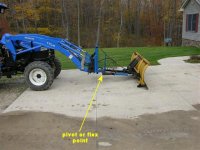<font color="blue"> PineRidge: The opposite is true for a front plow. A non-floating blade will vary the amount of weight on the front wheels causing a loss of steering ability when encountering pavement higher than the front wheels. When encountering down slopes or pavement lower than the front wheels, the plow will leave snow on the pavement. Essentially, when the fixed blade encounters an upslope, the front wheels get light or lift from the pavement or the blade gouges--one or the other. The plow will not follow the contour of the pavement unless it is floating. It will either be above it or trying to get below it, and rarely just in light contact.
You really do not want a non-floating blade for snow plowing on the front of any vehicle. You do want a fixed blade for grading soil and loose materials, though. Also, make sure there is a trip or spring trip for when that plow hits an immovable object </font>
Think I may have been misunderstood.
Here is what we said:
I think that if you use the float position you'll find a loss of steering. I'm thinking some flex between the plow and the loader would be best, then you can lower the plow to contact the drive and steering wouldn't be an issue. That way the plow can follow the contour of your drive.
If you look at the picture that we posted you will see that the blade does indeed flex on the plow mount/loader allowing up and down movement of the snowplow to follow the contour of the drive without loss of steering.
Here is what we meant:
If the loader is placed into float and the loader arms are allowed to contact the ground then steering loss will be an issue.


